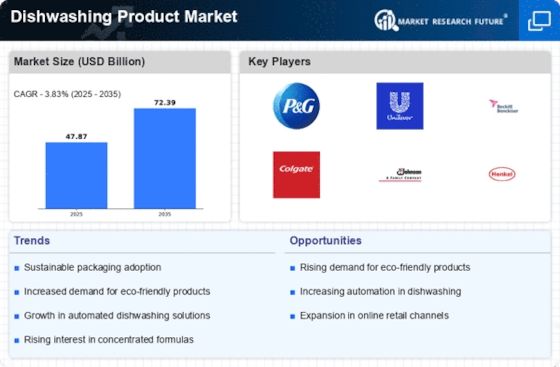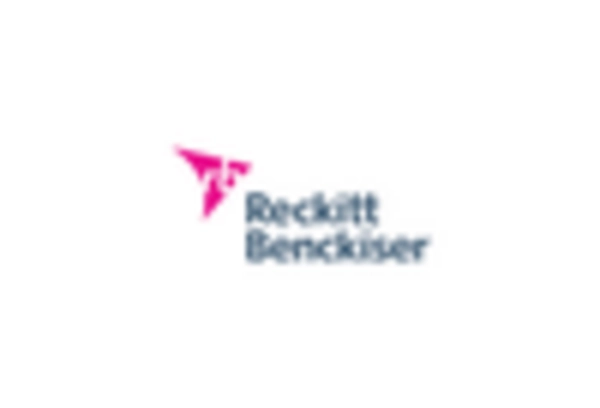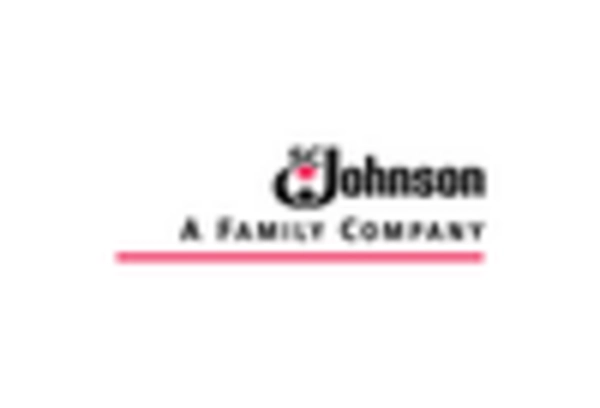E-commerce Expansion
The rise of e-commerce has significantly impacted the Dishwashing Product Market. With the increasing preference for online shopping, consumers are now able to access a wider range of dishwashing products than ever before. This trend is supported by data showing that online sales of household cleaning products, including dishwashing items, have surged by 30% in the past year. Retailers are enhancing their online platforms to provide better customer experiences, including subscription services and personalized recommendations. As e-commerce continues to expand, it is expected that the Dishwashing Product Market will see a shift in distribution channels, with more consumers opting for the convenience of online purchasing.
Sustainability Initiatives
The Dishwashing Product Market is increasingly influenced by sustainability initiatives. Consumers are becoming more environmentally conscious, leading to a demand for eco-friendly dishwashing products. This shift is evident as brands introduce biodegradable and phosphate-free detergents. According to recent data, the market for sustainable dishwashing products is projected to grow at a compound annual growth rate of 8% over the next five years. Companies are investing in sustainable packaging and production processes, which not only appeal to eco-conscious consumers but also comply with stringent regulations. As a result, the Dishwashing Product Market is witnessing a transformation that aligns with global sustainability goals, potentially reshaping consumer preferences and purchasing behaviors.
Technological Advancements
Technological advancements play a pivotal role in the Dishwashing Product Market. Innovations in formulation chemistry have led to the development of more effective and efficient dishwashing products. For instance, the introduction of enzyme-based detergents has enhanced cleaning performance while reducing the need for harsh chemicals. Furthermore, advancements in packaging technology, such as single-use pods, have gained popularity among consumers seeking convenience. Market data indicates that the segment of liquid dishwashing products is expected to account for over 50% of the market share by 2026, driven by these technological innovations. As manufacturers continue to invest in research and development, the Dishwashing Product Market is likely to experience ongoing evolution in product offerings.
Changing Consumer Lifestyles
Changing consumer lifestyles are reshaping the Dishwashing Product Market. As more individuals lead busy lives, there is a growing demand for convenient and time-saving dishwashing solutions. This trend is reflected in the increasing popularity of automatic dishwashers and pre-packaged dishwashing products. Data suggests that the market for automatic dishwashing detergents is projected to grow by 7% annually, driven by the rising adoption of dishwashing machines in households. Additionally, consumers are seeking products that offer multi-functionality, such as those that clean and sanitize in one step. As lifestyles continue to evolve, the Dishwashing Product Market must adapt to meet the changing needs and preferences of consumers.
Health and Hygiene Awareness
Health and hygiene awareness has become a crucial driver in the Dishwashing Product Market. The growing emphasis on cleanliness and sanitation has led consumers to prioritize effective dishwashing solutions. This trend is particularly evident in households and commercial establishments where hygiene standards are paramount. Market Research Future indicates that the demand for antibacterial and disinfecting dishwashing products has increased, with sales rising by 25% in the last year. As consumers become more informed about the importance of hygiene, the Dishwashing Product Market is likely to adapt by introducing products that meet these heightened expectations, thereby influencing purchasing decisions.


















Leave a Comment